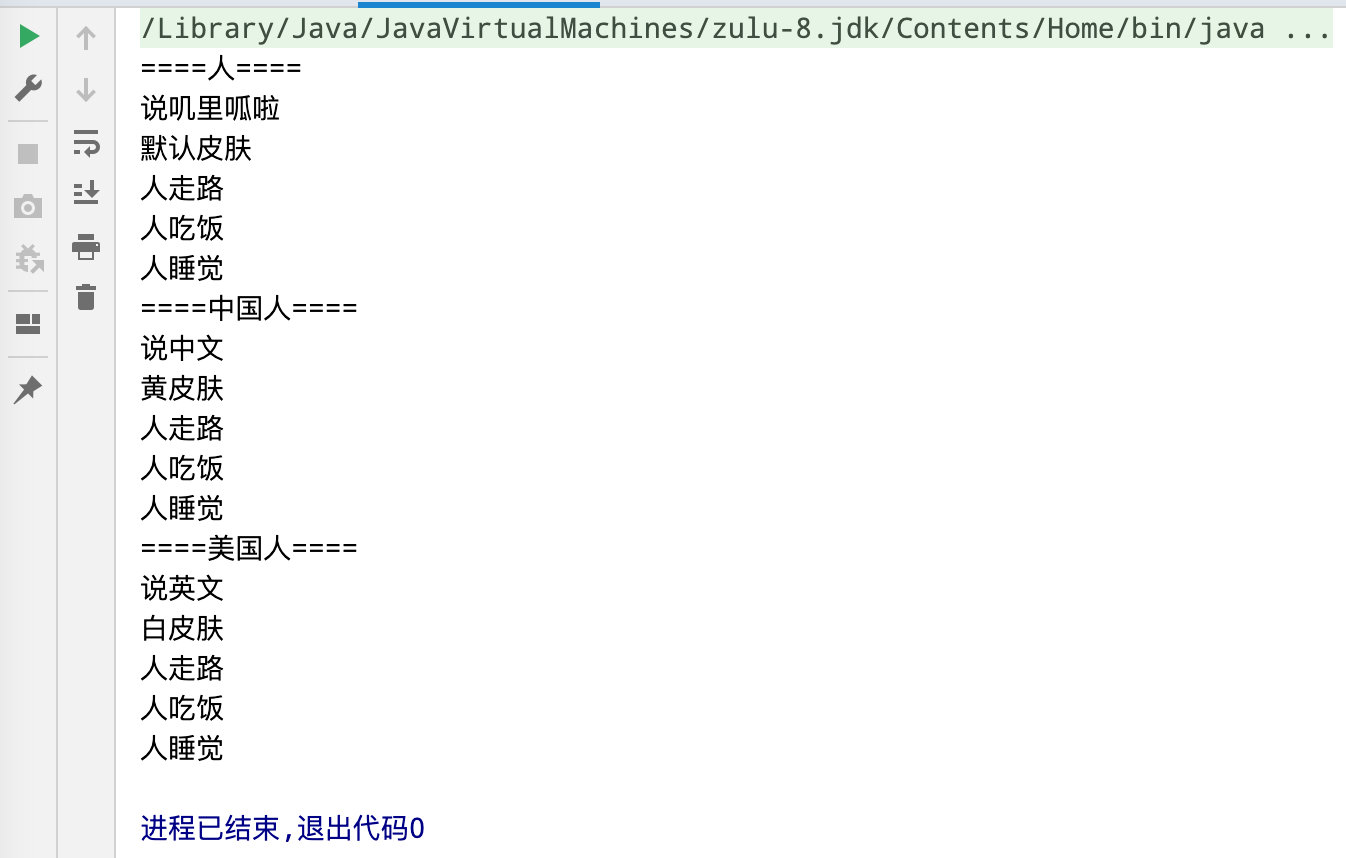一、“多态”的理解
先看Java代码:
java
public class Example {
public static void main(String[] args) {
System.out.println("====人====");
Person person = new Person("叽里呱啦","默认皮肤");
person.say();
person.showSkin();
person.walk();
person.eat();
person.sleep();
//多态
System.out.println("====中国人====");
Person chinese = new Chinese("中文","黄皮肤");
chinese.say();
chinese.showSkin();
chinese.walk();
chinese.eat();
chinese.sleep();
System.out.println("====美国人====");
Person american = new American("英文","白皮肤");
american.say();
american.showSkin();
american.walk();
american.eat();
american.sleep();
}
}
class Person {
String language;
String skinColor;
public Person() {}
public Person(String language, String skinColor) {
this.language = language;
this.skinColor = skinColor;
}
public void say(){
System.out.println("说"+this.language);
}
public void showSkin(){
System.out.println(this.skinColor);
}
public void walk(){
System.out.println("人走路");
}
public void eat(){
System.out.println("人吃饭");
}
public void sleep(){
System.out.println("人睡觉");
}
}
class Chinese extends Person {
public Chinese(){}
public Chinese(String language, String skinColor) {
super(language,skinColor);
}
}
class American extends Person {
public American(){}
public American(String language, String skinColor) {
super(language,skinColor);
}
}运行结果:

总结:多态的意义就是,当new出来的对象中自己“独特的”方法时,默认采用申明类型中“普遍的”方法,“多态”这一词的含义就来源于这种用于对创造的对象的广泛性的意义。
二、“向上转型”和“向下转型”的用法
java
class Animal{
public void shout() {
System.out.println("动物叫");
}
public void eat(){
System.out.println("动物吃");
}
}
class Dog extends Animal{
@Override
public void shout() {
System.out.println("狗叫");
}
public void home() {
System.out.println("狗看门");
}
}
class Cat extends Animal{
@Override
public void shout() {
System.out.println("猫叫");
}
public void sleep() {
System.out.println("猫趴窝");
}
}
public class AnimalInf{
//public static void shout(Animal an) {
// an.shout();
//}
public static void main(String[] args) {
Dog dog1 = new Dog();
Animal dog2 = new Dog();//向上转型后只会调用父类中方法
System.out.print("dog1.shout():");
dog2.shout();
System.out.print("dog2.shout():");
dog2.shout();//虽然转型成了Animal类,但是因为Dog类中重写了shout方法,所以是“狗叫”,这就叫《方法的调用看父类,运行结果看子类,重写的方法看子类》
System.out.print("dog1.home():");
dog1.home();
System.out.print("dog2.eat():");
dog2.eat();//调用了Animal类中的方法,
// dog2.home();//这里会报错,因为向上转型调用方法看左边,结果看重写,而Animal类中没有home方法
Dog dog3 = (Dog)dog2;//向下转型后,dog2才成为了一个Dog类的对象
System.out.print("dog3.shout():");
dog3.shout();
System.out.print("dog3.home():");
dog3.home();
System.out.print("dog3.eat():");
dog3.eat();
//用instaceof测试一个对象是否为一个类的实例
Animal cat1 = new Cat();
System.out.println(dog1 instanceof Dog);//true
System.out.println(dog2 instanceof Animal);//true
System.out.println(cat1 instanceof Dog);//false
System.out.println(cat1 instanceof Cat);//true,因为cat1是Cat的间接子类
System.out.println(cat1 instanceof Animal);//true
/*
会报错ClassCastException的异常,因为不能由子类(Dog)推出父类(Animal)中的细节,多态因该是由上到下的"抽象模糊形态"
Dog dog = (Dog) new Animal();
dog.eat();
*/
}
}